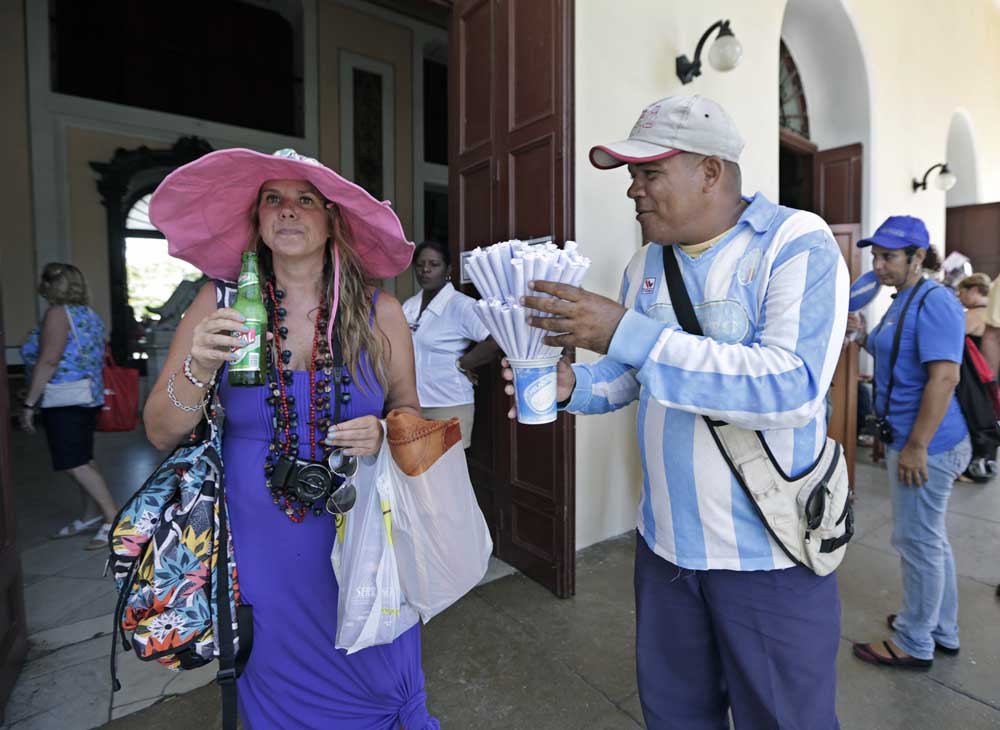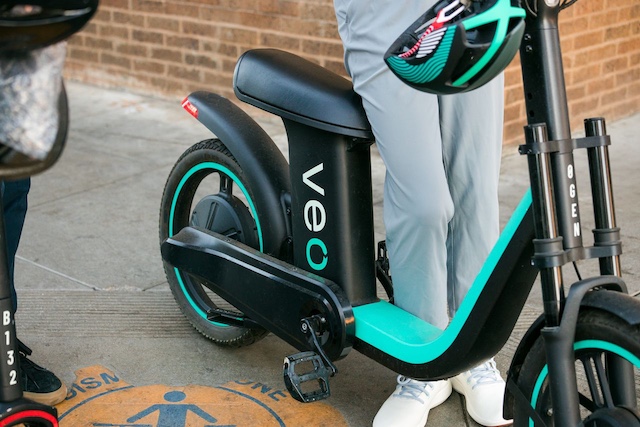The next wave for Cuba tourism: cruises
Published 6:05 am Thursday, March 30, 2017

- "Peanuts, peanuts," Anthony Garc'a calls out in English. Garc'a charges one Cuban convertible peso (CUC), which is just over $1, for the nuts and can earn 20 to 40 CUCs per day selling to tourists at Tomas Terry Theatre on Thursday, Sept. 8, 2016 in Cienfuegos, Cuba. (Al Diaz/Miami Herald/TNS)
Havana was exploding in yanqui frenzy. Seven hundred Americans streamed across its streets one steamy May 2016 morning on an expedition of rediscovery. They were the first to arrive via sea since John F. Kennedy was president.
The wave of change was crashing over Cuba.
Trending
For passengers on this historic voyage, the visit included hours of tours through the city’s highlight reel. Dinner at a private Cuban restaurant, “un paladar.” Rides in classic — Cubans would call them rustic — 1950s cars, “los almendrones.” Strolls through the centuries-old Spanish squares of La Habana Vieja.
But for Miami cruise expert Stewart Chiron and his son Bryan, then 13, Cuba’s unique allure really came to life when they walked into a Havana historical powerhouse: el Hotel Nacional.
Built in 1930 by a U.S. firm and U.S. architects, el Nacional was a haven for American mobsters and starlets. It also was the scene of a bloody siege key to the eventual rise of former dictator Fulgencio Batista. A bunker on the grounds dates to the Cuban Missile Crisis — the threat that eventually prompted Kennedy to sign the Cuba trade embargo that banned most trade and travel between U.S. citizens and the Communist island.
The embargo is still in place. But rules relaxed in 2014 by the U.S. government that allow its citizens to visit for cultural exchanges brought about 615,000 U.S. tourists last year to taste the long-forbidden apple in the Caribbean’s Garden of Eden. This year, an estimated 172,000 tourists will come via nine ships from eight U.S.-based cruise lines.
Until now, other travel sectors, such as airlines and hotels, have struggled to satiate a massive American appetite to see Cuba while dealing with the island’s antiquated infrastructure. Airlines have reduced flights, and hotels have lowered their inflated prices. The cruise lines are expected to face that conundrum, too, but to a much lesser degree because their unique form of accommodation offers a protection from the island’s shortage of modern hotels and efficient highways — for now.
“Everybody knows, both here and there, that there will have to be infrastructure development to support the onward growth,” said Adam Goldstein, president and chief operating officer of Royal Caribbean Cruises, whose lines Royal Caribbean International and Azamara Club Cruises will sail to Cuba this year. “Those are just the realities of going to a place that is super interesting and has limitations (and) constraints.” Over time, Cuba’s restaurants, ports, roads, hotels and other tourist facilities will improve, he believes. “But all of that is (still) totally in its infancy.”
Trending
In the travel boom spurred by former President Barack Obama’s 2014 announcement of detente, international hotel companies signed building contracts and airlines scrambled to earn a chunk of the 110 available daily flight slots. U.S. arrivals in Cuba ballooned 34 percent between 2015 and 2016, according to Josefina Vidal, Cuba’s chief negotiator with the U.S.
Hotel rates soared between 100 percent and 400 percent, with rooms previously priced at $150 per night skyrocketing to $650, according to New York-based tour operator Insight Cuba. American Airlines, JetBlue, Spirit and others started operating daily flights to 10 cities, including airports that hadn’t welcomed U.S. airlines in decades.
As the dust has started to settle, hotel rates have normalized. Airlines that overshot demand for Cuba are cutting back on routes and using smaller planes. The reason: Cuba can be comparatively expensive and traveling there is sometimes cumbersome.
The average round-trip airfare for Cuba from the Miami area was about $342 in February, according to data from Airlines Reporting Corp. While less than the Caribbean round-trip average that month of $594, the fare is relatively high for travel to an island that has a limited number of hotel rooms — only 64,231 in 2015, according to a December Florida International University report on tourism in Cuba, or about 10,000 more than in Miami-Dade — meaning travelers may be hard pressed to find accommodations in their budget. Even taxi drivers, classic car drivers and paladar owners have increased their prices, sometimes doubling or tripling them, according to Insight Cuba.
But many of those challenges don’t exist on a cruise ship. So while airlines have cut back, cruise lines have pushed forward, adding itineraries through the end of the year. By the end of 2017, eight U.S. lines — seven based in Miami — will offer Cuba itineraries. Sailings aboard Carnival Corp.’s pioneering Fathom, which inaugurated U.S. cruise service, will be discontinued after June, but only because demand for its every-other-week trips to the Dominican Republic didn’t match the strength of its Cuba component.
“The cruise industry is pretty well contained, so we bring our own food, we bring our own garbage disposal systems, we want to leave as little footprint as possible but add to the economic prosperity that tourism overall brings,” said Frank Del Rio, president and CEO of Norwegian Cruise Line Holdings, which will sail to Cuba on all three of its lines: Norwegian Cruise Line, Oceania Cruises and Regent Seven Seas.
Ships also bring their own accommodations, skirting hotel infrastructure limitations, and set up the excursions to ensure travelers follow U.S. guidelines. The trips are paid for ahead of time. (Hotel rentals and all purchases on the island are cash transactions.)
“There’s less hoops people have to go through,” said Debbie Fiorino, vice president of Fort Lauderdale, Florida-based travel agency CruiseOne/Dream Vacations and Cruises Inc. “You don’t have to worry if everything in Cuba is built up.”
That’s why Olga Cormier, who lives in Miramar, Florida, is visiting Cuba via a ship. The avid cruiser, who is of Cuban heritage, has plans for a fall trip on Norwegian Cruise Line’s 2,004-passenger Norwegian Sky, one of the largest American ships sailing to the island, because the ship has an overnight stay in Havana.
“It’s just with all the time and limitations and everything else, I don’t know that I’m ready to go via plane ride and do the whole tourist thing that way,” Cormier said. “One of the advantages of cruising is that it is sort of a sampler platter — you see a place and then decide if you want to go and stay.”
Managing massive growth
On the wall behind Del Rio’s desk in his Miami office are two large, slightly yellowed, black-and-white photographs of cruise ships entering Havana Harbor in the 1930s. The space next to it is blank, ready to welcome an image shot this month, when Oceania’s Marina sailed into Havana.
“I’ve said for many years that in my upper right hand drawer there are itineraries ready to go, and they were ready the day I launched Oceania back in 2003,” said Del Rio, who emigrated from Cuba in 1961 at age 6.
That was the same year American cruise ships stopped calling in Cuba. Then, thanks to financial support from the Soviet Union, Cuba stopped relying on tourism. That was in stark contrast with the 1950s, when cruising to Cuba from the U.S. was a staple, said Christopher Baker, a Cuba expert and travel writer.
Then in 2014, some European lines began calling in Cuba on their weekly winter sailings, Baker said. Those included Greek line Variety Cruises, French lines Le Ponant and Club Med, Swiss line MSC and British line Noble Caledonia.
The small ships of those European lines have “not put undue stress” on Havana, Baker said. The port there features a modest air-conditioned terminal and space for a medium-sized cruise ship (no bigger than Norwegian’s 850-foot long Sky) on one side and a small vessel on the other.
The Oceania ships are considered small compared to some of the world’s largest; the 1,250-passenger Marina and 684-passenger Insignia, which will both go to Cuba, are a fraction of the size of Royal Caribbean International’s 6,000-passenger plus ships. But Norwegian Cruise Line’s 2,004-passenger Sky is slated to overlap on its trips to Havana with Royal Caribbean International’s 1,602-passenger Empress of the Seas nearly a dozen times this year. That will dump more than 3,000 tourists into the Cuban capital at once.
That volume is more than four times the number of passengers Fathom was unloading in Havana on a bimonthly basis last year when it was the only American line in Cuba. Through the end of the year, cruise ships will be in Havana about five days a week, according to the line’s announced itineraries.
“It has been rare to find more than one cruise ship at a time berthed in Havana,” Baker said in an email. “I expect that the arrival of larger ships will begin to test the infrastructure. More buses and guides will be required to ferry passengers once ashore; lunchtime restaurants will be squeezed to accommodate all the passengers; and the plazas of colonial Habana Vieja are already crowded.”
Baker said the cruise influx has displaced U.S. tour operators, which have been operating people-to-people trips in Cuba for several years, from restaurants, leading tour companies to complain about getting crowded out of popular venues.
And cruise ship passengers, unlike land-based travelers, are less likely to financially support the country’s growing roster of private homeowners who rent their homes or run restaurants, Baker said.
“Cruise ship passengers are less likely to contribute directly to the local economy, as their spending is typically relegated to the purchase of souvenirs; the key benefit will be to the Cuban state for berthing fees and charges for the use of state-employed guides and buses,” Baker said.
Tom Popper, president of Insight Cuba, which has been leading U.S. tours on the island since 2000, said the cruise influx creates challenges for on-the-ground tour operations — but only for short periods and for a worthy payoff, he said.
“Any kind of opportunity for Cuba to get into the 21st century and be a viable tourist destination is going to involve these things and involve change,” Popper said.
Still, there is a chance President Donald Trump may throw a monkey wrench into the situation.
Politics play a large role in Cuba’s decision to make large infrastructure changes or approve additional tourism into the island, Popper said.
“It’s just the way their apparatus works — with extreme caution. They have limited resources, and the embargo has a very cataclysmic effect on their economy,” he said. “Their philosophy has always been, ‘When we see it, we will build it.’”
The Cuban government’s only announced tourism goal is to add 108,000 hotel rooms to the existing stock of three-star or better accommodations by 2030. That objective would require a $33 billion investment, according to the Florida International University study. The study predicts it is unlikely Cuba will meet that goal unless the embargo ends.
That possibility remains unlikely under Trump, who has previously warned that if the U.S. can’t strike a better deal that includes political concessions from the Cuban government, he may reverse Obama’s softened travel restrictions.
Worried about a potential change, more than 100 Cuban entrepreneurs sent Trump a letter in December detailing the importance of tourism, among other things, for economic growth on the island.
“An influx of American and Cuban-American visitors stimulates growth for our businesses, directly and indirectly,” the letter read. “Increased interaction and business dealings with U.S. travelers and U.S. companies has had important economic benefits, the exchanges of ideas and knowledge, and offered much hope for the future.”
A tearful welcome
In the grand scheme of Caribbean cruise travel, Cuba’s impact is limited. Only Norwegian has weekly trips to the island beginning in May, while the other lines have scattered trips scheduled around port availability.
“In terms of the materiality to our overall business portfolio, (Cuba) is de minimis — much less than 1 percent,” said Royal Caribbean’s Goldstein. “(Still), for many, many years, there has been a pent-up demand to be able to cruise to Cuba.”
Eventually, the lines foresee participating in infrastructure changes, said Norwegian Holdings’ Del Rio.
“(Improving port infrastructure) is something the cruise industry routinely does around the world to help the local authorities improve the cruise infrastructure faster than it otherwise might, and my guess is that Havana and the other Cuban ports will be no exception when we are allowed to do so,” he said.
Bookings for sailings featuring Cuba are strong, travel agents said, albeit less robust than at the height of the Cuba rush in 2015. Now, the cruise lines are entering the scene during Cuba’s “new normal” of heightened travel interest, Popper said.
“Cuba is going to remain one of those destinations for Americans for years because millions of people want to visit and they will over time,” he said. “If you’re Cuban and you live in Havana, you’re happy.”
For U.S. visitors like Chiron and his son, Cuba’s history will continue to be a lure. For them, the time at Hotel Nacional brought alive a past they had long heard about in Miami.
“There’s a window with a phone that dates back to the Cuban Missile Crisis, large cannons that were used to defend the port when they attacked the USS Montgomery (during the Spanish American war),” Chiron recalled. “(Later) we went back to the bar to have our first mojito, and you look at the pictures of the people on the wall, there are celebrities, but you had these big pictures of the president of China and you have (Russia’s) Vladimir Putin on the wall.
“It was interesting to see history from a different perspective.”
For their part, Cubans have welcomed American travelers with unexpected openness, said Baker, the Cuba expert.
“Cubans gave (Fathom’s) Adonia a tearful welcome,” Baker said. “It was immensely symbolic. Cubans love Americans, and U.S. visitors are often surprised at the degree to which Cubans on the street display their open affection for Americans.”
The eight U.S. cruise lines going to Cuba
• Norwegian Cruise Line on the 2,004-passenger Norwegian Sky
• Royal Caribbean International on the 1,602-passenger Empress of the Seas
• Carnival Cruise Line on the 2,052-passenger Carnival Paradise
• Azamara Club Cruises on the 690-passenger Azamara Quest
• Oceania Cruises on the 1,250-passenger Marina and 684-passenger Insignia
• Regent Seven Seas on the 700-passenger Seven Seas Mariner
• Pearl Seas Cruises on the 210-passenger Pearl Mist
• Fathom on the 704-passenger Adonia








